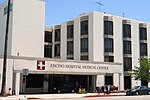Sherman Oaks Galleria

Sherman Oaks Galleria is an open-air shopping mall and business center located in the Sherman Oaks neighborhood of Los Angeles, California, United States, at the corner of Ventura and Sepulveda Boulevards in the San Fernando Valley. The teenage mall culture which formed around it and nearby malls formed the basis of the 1982 satirical song "Valley Girl" by Frank Zappa and daughter Moon Zappa, which mentions the Galleria by name (though it misattributes its location as Encino, which it abuts). The mall has also been a shooting location for many films, most notably the seminal 1982 film Fast Times at Ridgemont High as well as the 1983 film Valley Girl, both of which focused on the early 1980s San Fernando Valley youth culture.
Excerpt from the Wikipedia article Sherman Oaks Galleria (License: CC BY-SA 3.0, Authors, Images).Sherman Oaks Galleria
Ventura Boulevard, Los Angeles
Geographical coordinates (GPS) Address External links Nearby Places Show on map
Geographical coordinates (GPS)
| Latitude | Longitude |
|---|---|
| N 34.154166666667 ° | E -118.46666666667 ° |
Address
Sherman Oaks Galleria
Ventura Boulevard
91403 Los Angeles
California, United States
Open on Google Maps








